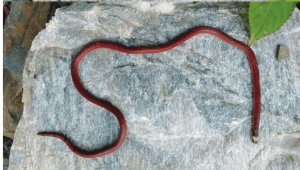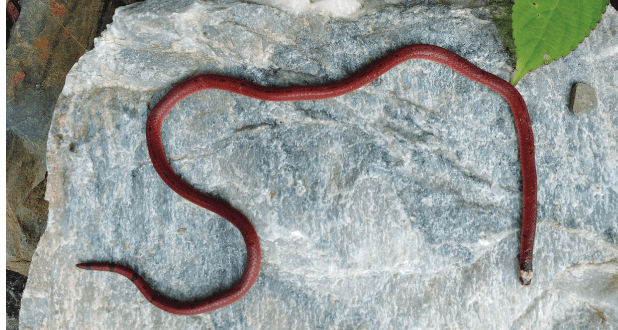 Black-bellied Coral snake has been discovered in forests of Uttarakhand for the first time in history, by a group of researchers. The snake belongs to the Elapidae family of the Sinomicrurus genus, namely, S. nigriventer.
Black-bellied Coral snake has been discovered in forests of Uttarakhand for the first time in history, by a group of researchers. The snake belongs to the Elapidae family of the Sinomicrurus genus, namely, S. nigriventer.
The researchers had also found a dead specimen of the same snake on August 11, 2019, in the Nainital Forest Division at an elevation of 1,113 metres. The dead specimen has been preserved in the museum of the Wildlife Institute of India, Dehradun.
Uttarakhand lies in the Western Himalayas and is home to unique plants and animals.
Know coral snakes
Coral snakes are a large group of elapid snakes that are venomous but commonly less involved in envenomation (an act or instance of poisoning by venom). Elapid snakes are fossorial and show solitary behaviour. They usually can be identified by their fangs.
According to the study, “Black-bellied Coral Snake Sinomicrurus nigriventer: An extended distribution in the western Himalaya, India”, published in the Journal of Threatened Taxa, there are currently 107 species of coral snakes belonging to five genera are recognized in the world.
In India, only seven coral snake species are found. According to a statement by Abhijit Das, one of the researchers, the coral snake was recently rediscovered in Himachal Pradesh, in the Solan district at an elevation of 870 metres.
Coral snake found in Uttarakhand’s forest
The live black-bellied coral snake was found in the Bhadraj Block of Benog Wildlife Sanctuary (BWS) in Mussoorie Forest Division on September 20, 2020 on way to the Bhadraj temple. The venomous snake is important for medical reasons.
It was found at an elevation of 1,914 metres. Since, both the specimens- live and dead, were found in the monsoon season, it may suggest some seasonal activity pattern. The study also suggested that the cool sub-tropical and temperate forests (1,000–2,000 m) with dense grassy slopes are under-explored in terms of reptilian diversity. The study also suggested that the threatened species is expanding its geographical area.
Snakes in India
According to 2015 report of the Ministry of Health & Family Welfare on the management of snakebite, there are more than 2000 species of snakes in the world. About 300 of these species are found in India, of which 52 are venomous.
The venomous snakes found in India belong to three families ‘Elapidae’, ‘Viperidae’ and Hydrophidae’ (sea snakes). The most common Indian elapids are Naja naja (Indian Cobra) and Bungarus caeruleus (Indian Krait), Daboia russalie (Russells’ Viper) and Echis carinatus (Saw scaled viper). These are also known as the ‘big four’.
Kraits are active during the night hours, often biting a person sleeping on the floor bed while maximum Viper and Cobra bites occur during the day or early darkness, or while watering the plantation or walking barefoot in the grass or farming lands.
Further, all snakes are protected by the law. Cobra, Rat snakes, and Checkered keelback are protected in Schedule II of Wildlife (Protection) Act, 1972, and the rest are protected by Schedule IV.
Why are snakes important?
Although snakes are deadly animals, venomous in nature, however, they use their venom to protect themselves from a suspected enemy or to feed on prey. However, these long, legless creatures are equally important to the ecology. Snakes are important mainly for two reasons, medical and environmental.
Venomous snakes have medical significance. snake antivenoms is a mixture made from venom extracted from the ‘big four’ snakes, cobra, krait, Russell’s viper, and the saw-scaled viper. Antivenom is used to treat a person who has been bitten by a snake.
Antivenoms are based on polyclonal antibodies derived from the plasma of hyperimmunized animals and remain the only specific treatment against animal envenomings.
On the other hand, snakes are important for the environment too. They are important to farming and to ecology. They not only keep the food web in balance but also use venom to control, kill and digest their prey. Without them, the numbers of prey species would increase to unnatural levels and those animals that eat snakes will struggle to find food.
Snakes use their highly-developed sense of sight, taste, hearing, and touch to locate, recognize and track their prey. Rats are known to damage crops and grains. Snakes are the only predators that can go inside a rat hole and prey on them. They play a significant role in controlling the rodent population.
Venom is also a weapon for snakes, which they use as a defence mechanism against an aggressive enemy. Once the venom enters the body, it may start affecting or targeting specific organs.
 Pressmediaofindia
Pressmediaofindia




